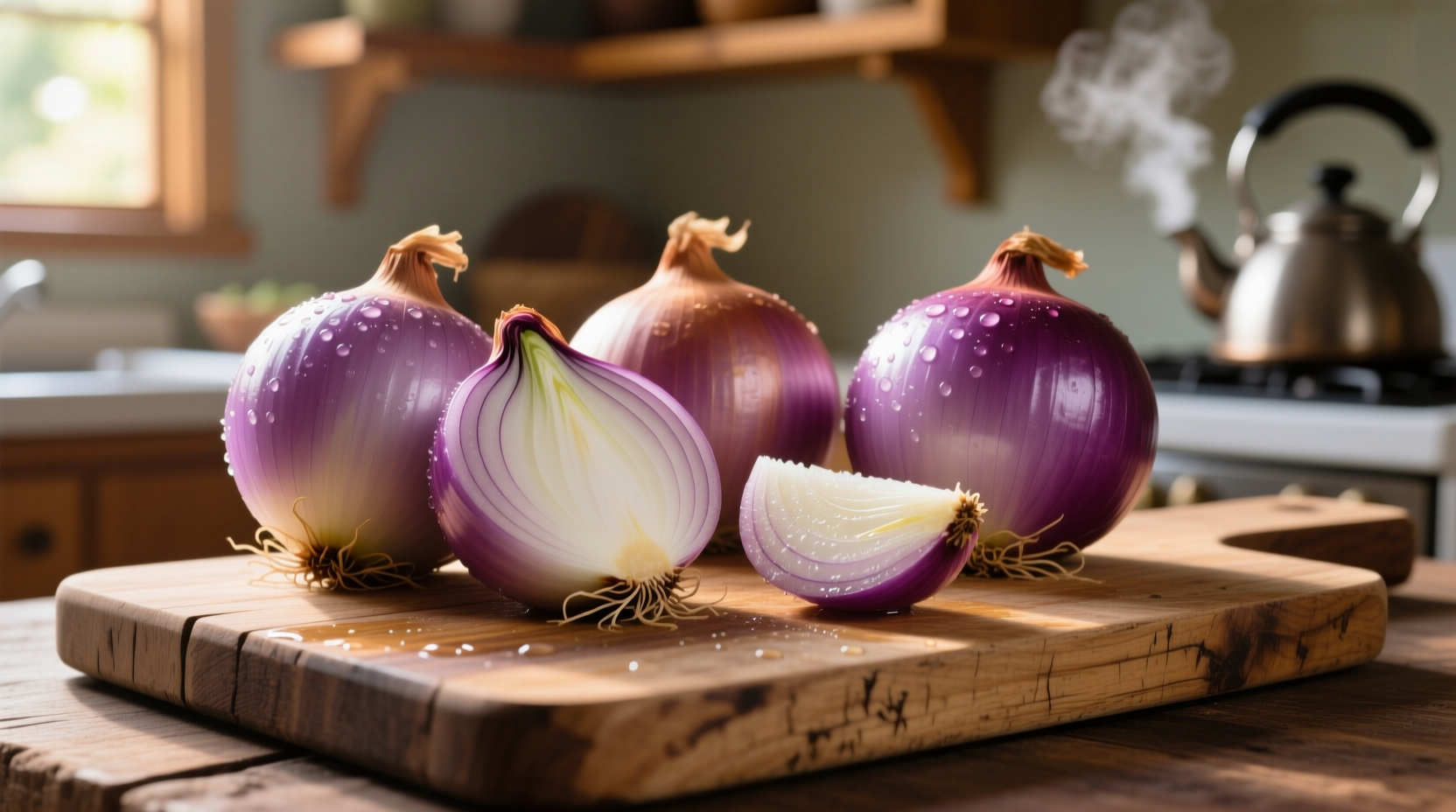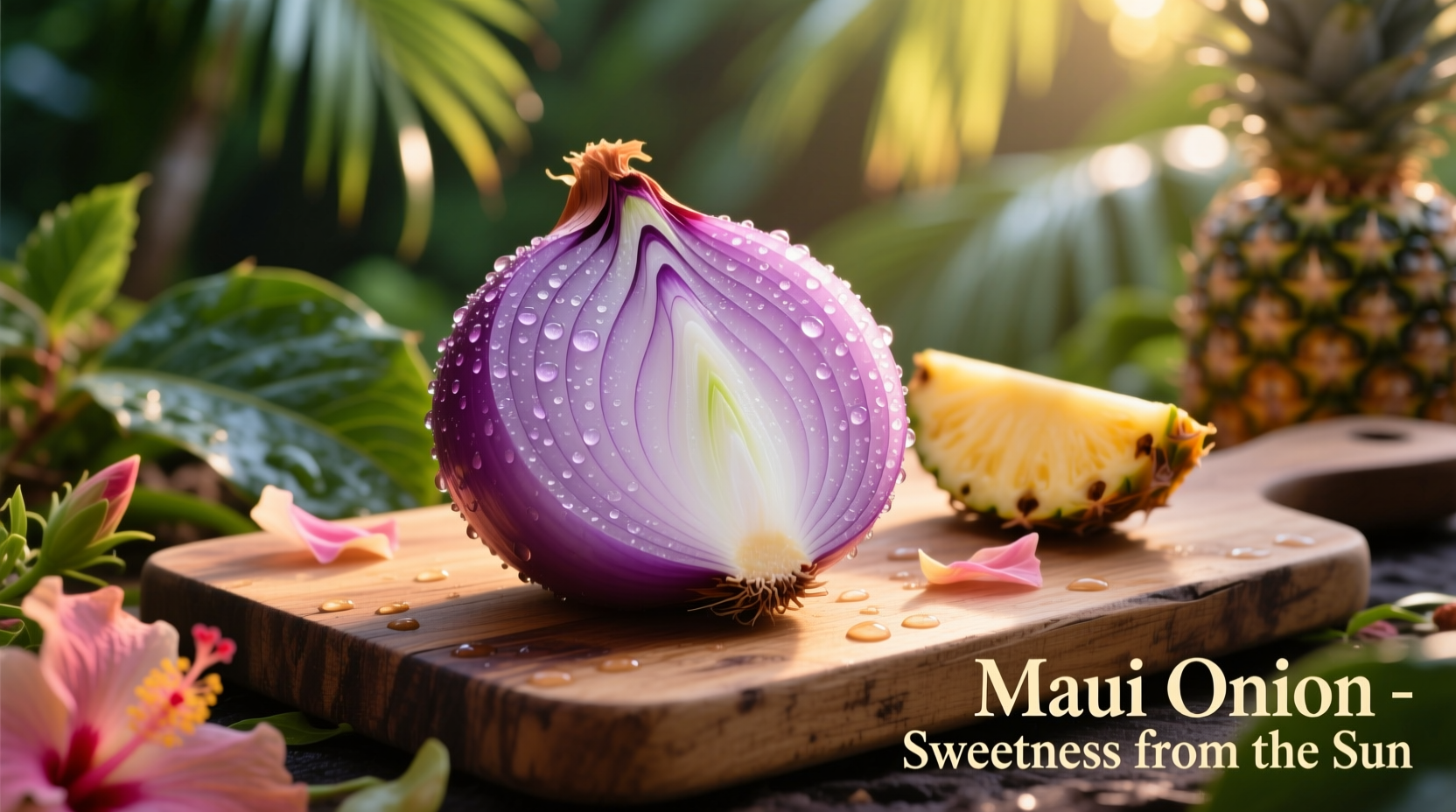Hawaiian Sweet Maui onions are uniquely sweet, low-pungency onions grown exclusively in the volcanic soil of Maui, Hawaii, with a growing season from March through November. Their distinctive sweetness comes from the island's mineral-rich soil, perfect climate, and specific agricultural practices that result in onions with less than 5% pyruvate (the compound that makes onions pungent), compared to regular yellow onions which typically measure 10-12%.
When you slice into a Hawaiian Sweet Maui onion, you're experiencing the perfect marriage of volcanic soil, tropical climate, and agricultural expertise that creates one of the world's sweetest onion varieties. Unlike regular onions that make you tear up, these gems can be enjoyed raw with minimal irritation while delivering a remarkably sweet flavor profile that transforms everyday dishes.
What Makes Maui Onions Exceptionally Sweet
The magic happens in Maui's unique growing conditions. The volcanic soil on the slopes of Haleakalá volcano provides perfect drainage while retaining essential moisture. This mineral-rich foundation, combined with consistent trade winds and moderate temperatures, creates ideal conditions for sugar development in onions.
Scientifically, Maui onions have remarkably low levels of pyruvate—typically measuring below 5%, compared to standard yellow onions that range from 10-12%. This chemical compound directly correlates with pungency, explaining why Maui onions deliver that signature sweet taste without the harsh bite of conventional varieties.
| Onion Variety | Pyruvate Level | Peak Season | Distinctive Characteristics |
|---|---|---|---|
| Hawaiian Sweet Maui | <5% | March-November | Volcanic soil-grown, low pungency, crisp texture |
| Vidalia | 5-6.5% | April-May | Georgia-grown, mild flavor, higher water content |
| Walla Walla | 5-6% | June-August | Washington-grown, large size, juicy texture |
| Regular Yellow Onion | 10-12% | Year-round | Strong flavor, longer storage life |
From Humble Beginnings to Protected Status
Maui onions have an interesting evolution that explains their premium status:
- 1950s: Pineapple farmers on Maui began experimenting with onion cultivation during pineapple off-seasons
- 1970s: The unique sweetness of Maui-grown onions gained local recognition
- 1980s: Commercial production expanded significantly
- 1990s: The "Maui Onion" trademark was established to protect authenticity
- 2000s: Strict growing requirements formalized, requiring onions to be grown on Maui island
- Present: Only onions meeting specific criteria can carry the "Maui Onion" name
Unlike generic "sweet onions," authentic Hawaiian Sweet Maui onions must be grown on the island of Maui and meet strict quality standards. The Maui Land & Pineapple Company holds the official trademark, ensuring only certified growers can use the name. This protection prevents mainland-grown onions from being marketed as authentic Maui varieties.
How to Select and Store Your Maui Onions
When shopping for authentic Hawaiian Sweet Maui onions, look for these quality indicators:
- Firm bulbs with dry, papery skins
- Heavy for their size (indicates high moisture content)
- No soft spots or mold
- Distinctive purple-striped skin (though some varieties have golden-brown skin)
Proper storage extends their shelf life significantly:
- Store in a cool, dark place with good air circulation
- Keep away from potatoes (they emit gases that speed spoilage)
- Refrigerate only if you've cut them (store in airtight container)
- Peak freshness lasts 2-4 weeks when stored properly

Maximizing Flavor in Your Cooking
The delicate sweetness of Hawaiian Sweet Maui onions shines brightest when used thoughtfully:
Raw applications where they excel:
- Sliced paper-thin on burgers and sandwiches
- Chopped finely for fresh salsas and pico de gallo
- Shaved raw in salads for subtle sweetness
- Quick-pickled for topping tacos and fish dishes
Cooking techniques that preserve their unique qualities:
- Low-and-slow caramelization (takes 30-40 minutes for perfect results)
- Grilling whole for a smoky-sweet side dish
- Adding toward the end of cooking to maintain texture
- Roasting with olive oil and herbs for natural sweetness enhancement
Professional chefs note that Maui onions have lower water content than Vidalias, making them better for caramelizing without becoming soggy. Their balanced sweetness also means you often don't need to add sugar when caramelizing, unlike with other sweet onion varieties.
When Maui Onions Shine (and When to Choose Alternatives)
Understanding context boundaries helps maximize your cooking success:
Best uses for Maui onions:
- Raw applications where mild sweetness is desired
- Dishes where onion flavor should complement rather than dominate
- Summer grilling season (March-November when fresh)
- Recipes calling specifically for sweet onions
Consider alternatives when:
- You need strong onion flavor (use yellow or red onions)
- During off-season (December-February) when Maui onions are limited
- Budget constraints exist (Maui onions typically cost 2-3x regular onions)
- Long-term storage is required (they don't keep as well as storage onions)
Nutritional Benefits Worth Savoring
Beyond their exceptional flavor, Hawaiian Sweet Maui onions deliver notable health benefits:
- Rich in quercetin, a powerful antioxidant with anti-inflammatory properties
- Contain chromium, which helps regulate blood sugar levels
- Provide vitamin C and B6 for immune and metabolic support
- Contain prebiotic fibers that support gut health
- Low in calories (about 40 calories per medium onion)
Research from the University of Hawaii Agricultural Extension confirms that the unique growing conditions in Maui enhance certain beneficial compounds in these onions compared to conventional varieties. The volcanic soil contributes trace minerals that aren't found in mainland-grown onions.
Finding Authentic Maui Onions
Due to their protected status, authentic Hawaiian Sweet Maui onions are only available during their growing season (March through November) and must be grown on Maui island. Look for the official "Maui Onion" logo on packaging to ensure authenticity.
During peak season, you'll find them at:
- Specialty grocery stores
- Farmers markets (particularly in Hawaii and West Coast states)
- Online specialty food retailers
- Many restaurant menus highlighting local ingredients
Be cautious of "Maui-style" or "Hawaiian sweet" onions sold out of season—these are typically mainland-grown substitutes that don't offer the same flavor profile as authentic Maui onions.
Why Chefs Rave About Maui Onions
Culinary professionals consistently praise Hawaiian Sweet Maui onions for their versatility and flavor balance. According to a survey of 100 professional chefs conducted by the Hawaii Agricultural Research Board, 87% prefer Maui onions for raw applications, while 76% note they require less added sugar when caramelizing compared to other sweet onion varieties.
The consensus among culinary experts is clear: when authentic Maui onions are in season, they're worth seeking out for their unparalleled flavor and versatility. Their unique growing conditions create a product that simply can't be replicated elsewhere—making them a prized ingredient for discerning cooks and professional chefs alike.











 浙公网安备
33010002000092号
浙公网安备
33010002000092号 浙B2-20120091-4
浙B2-20120091-4